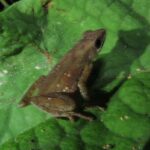- Meet Callulina meteora: Tanzania's Enigmatic Mountain Frog
- Taxonomy and Scientific Classification
- A Mist-Cloaked Habitat: The Natural Home of <em>Callulina meteora</em>
- Physical Characteristics: Adaptations for Life in the Clouds
- Behavior and the Secretive Life Cycle
- The Ecological Significance of <em>Callulina meteora</em>
- Threats, Conservation Status, and Ongoing Efforts
- Cultural and Scientific Appeal of <em>Callulina meteora</em>
- Conclusion: Celebrating and Protecting Nature's Wonders
Meet Callulina meteora: Tanzania’s Enigmatic Mountain Frog#
Amidst the mist-shrouded peaks and dazzling biodiversity of Tanzania’s Eastern Arc Mountains, hides a creature as mysterious and intriguing as the habitat it calls home. Known scientifically as Callulina meteora, this enigmatic amphibian captivates researchers and nature enthusiasts alike with its peculiar charm, elusive nature, and the crucial ecological niche it fills. A relatively novel discovery in the sphere of herpetology, the amphibian first described in 2011, captured immediate attention for its remarkable beauty, subtle uniqueness, and heightened vulnerability. But what precisely makes Callulina meteora so special?
Picture this: a frog whose distinctively textured skin mirrors the rugged terrain where it dwells, boasting hues ranging from subtle earth-browns to vivid rust-colored splashes, perfectly adapted to blend seamlessly into its surroundings. Rarely larger than a few centimeters, yet profoundly significant, this small amphibian has become a living symbol—informing scientists about ecosystem health and calling our attention to the delicate balance within Tanzania’s mountain forests. Let’s explore further into the world of Callulina meteora, unraveling the secrets of its natural history, life cycle, ecological interactions, and conservation status.
Taxonomy and Scientific Classification#
Before diving into the wondrous depths of its habitat and behaviors, let us first understand where Callulina meteora sits within the tree of life. This species belongs to a unique amphibian family known as Brevicipitidae, comprising frogs characterized by their squat bodies, direct development (bypassing the tadpole stage), and distinctive vocalization. Within the genus Callulina, these frogs are commonly known as warty frogs or spiny frogs—owing to their textured skin and minute, granular warts.
First formally identified by a team of skilled herpetologists in 2011, Callulina meteora stands testament to the ongoing discovery of hidden biodiversity in remote regions. Its genus, Callulina, currently includes several closely related species, all found predominantly within the Eastern Arc Mountains of Tanzania and southern Kenya—a region recognized as one of Africa’s biodiversity hotspots.
A Mist-Cloaked Habitat: The Natural Home of Callulina meteora#
One cannot truly grasp the charm of this amphibian without imagining the ethereal landscapes it inhabits. Callulina meteora is endemic to Tanzania’s Nguru South Mountain forests, a part of the famed Eastern Arc Mountains range. Breathtaking and ancient, these evergreen montane forests are perpetually enveloped in mist, their lush vegetation thriving under constant moisture.
This frog prefers high-altitude montane forests, usually found at elevations between approximately 1900m to 2100m above sea level—a testimony to its highly specialized habitat preferences. Within this environment, Callulina meteora typically inhabits dense leaf litter, moss-covered branches, and damp, shaded crevices amongst the rocky terrain, providing ideal microhabitats for camouflage, moisture retention, and predator avoidance.
The species effortlessly blends into its environment, literally merging with the colors and textures of rich earth and lichens. In fact, its cryptic appearance acts as a natural defense against predators, allowing it to remain undetected amid shadows and foliage—a master of disguise, whispered about among local conservationists as the “ghost of the mist-shrouded forests.”
Physical Characteristics: Adaptations for Life in the Clouds#
Small yet striking, Callulina meteora rarely surpasses 40mm in length. What it lacks in size, however, it compensates for with undeniable visual appeal and intriguing adaptations. The most notable feature is undoubtedly its granular skin texture, studded with minute wart-like protrusions. Rather like rough tree bark or moss-covered rock, this specialized skin texture is a brilliant evolutionary response to its microhabitat.
Coloration in this species combines shades of deep browns, rich ochres, and sometimes subtle greens, often accentuated by speckles or blotches—all serving as masterful camouflage. Their stocky frame and robust limbs suggest terrestrial adaptations, best utilized for navigating thick vegetation, leaf litter, and rocky crevices in search of food, mates, and shelter.
Moreover, as is common to their family, Callulina meteora does not depend on standing water bodies to lay eggs. Instead, eggs laid terrestrially hatch directly into fully formed juvenile frogs—an evolutionary strategy known as direct development. This incredible adaptation allows survival in high-altitude environments where standing water bodies are scant.
Behavior and the Secretive Life Cycle#
The cryptic and elusive nature of this species makes comprehensive knowledge of their social behavior challenging to gather. Nonetheless, field observations and ecological data have unveiled captivating insights. Primarily nocturnal, Callulina meteora emerges under the cover of darkness, actively hunting small insects, spiders, mites, and other invertebrates it discovers within leaf litter and forest-floor detritus.
One mysterious, fascinating behavior of this species involves their vocal communication. The males possess vocal sacs enabling them, during rainy evenings, to produce a distinctive “chirruping” call—believed to serve the dual purpose of territory establishment and attracting female frogs. Although each call lasts only a fraction of a second, when magnified collectively among numerous males calling simultaneously, the soundscape reverberates through the misty forests at night, rendering the Nguru Mountains alive with a symphony of amphibian songs.
Breeding behaviors remain relatively understudied for this particular frog. However, given its close relatives and known lifecycle patterns within its genus, we know that female frogs typically deposit eggs in hidden moist places, far from water pools. After fertilization, these terrestrial nests hatch into small froglets—fully functional miniature versions of the adult frog, skipping entirely the aquatic tadpole phase characteristic of many other amphibians.
The Ecological Significance of Callulina meteora#
Understanding the ecological role Callulina meteora plays provides a window into the delicate balance of montane forests and their biodiversity. Often termed “bioindicators,” species in the genus Callulina serve as accurate reflections of ecosystem health. Amphibians are highly sensitive to environmental changes, experiencing disruptions due to climate fluctuations, habitat alteration, or contamination rapidly and dramatically.
As voracious insectivores, these small frogs keep local invertebrate populations in balance, thus playing a subtle yet powerful role in regulating lower trophic-level species dynamics. Equally importantly, their position as prey provides vital sustenance for higher trophic-level species, including birds, small mammals, and reptiles, therefore supporting a balanced and resilient ecosystem.
Threats, Conservation Status, and Ongoing Efforts#
Unfortunately, the survival of Callulina meteora hangs tenuously amidst threats both local and global. Although formally assessed as critically endangered on the IUCN Red List, the frog’s restricted geographic range makes its population highly vulnerable. Habitat destruction from logging, agricultural expansion, and human settlement encroachment remains the top culprits spelling danger for these sensitive montane forests.
Climate change exacerbates these issues, increasing temperature fluctuations, altering moisture patterns, and intensifying drought spells—all particularly damaging for species specialized to cooler, mist-covered habitats. Protecting existing habitat, supporting the establishment and careful management of protected areas, and conducting ongoing population monitoring are vital conservation actions.
Several international and locally-led conservation initiatives actively seek to restore and connect fragmented forest habitats in Tanzania, while education-based programs emphasize local communities’ involvement in reducing human pressures on threatened ecosystems.
Cultural and Scientific Appeal of Callulina meteora#
Despite its obscurity outside specialized conservation circles, locals often recognize the presence and keep stories—not always scientific—of the mysterious little frog inhabiting their ancestral forests. Scientifically, each discovery—such as Callulina meteora—offers vital insights into Earth’s rich biodiversity heritage, enhancing our understanding of evolution, ecology, and the intricate connections between species within complex, diverse ecosystems.
Conclusion: Celebrating and Protecting Nature’s Wonders#
Callulina meteora is more than an ordinary frog; it is a flagship for conservation, biodiversity, and ecological stewardship within the Eastern Arc Mountains. Its continuing survival relies not just on scientific recognition but on the collective protective actions we undertake.
As advocates for wildlife, nature lovers, or simply curious human beings, our voice and actions matter: exploring more about creatures like Callulina meteora, supporting conservation initiatives, and, above all, speaking up for the silent, unseen wonders hidden in our planet’s forests.







